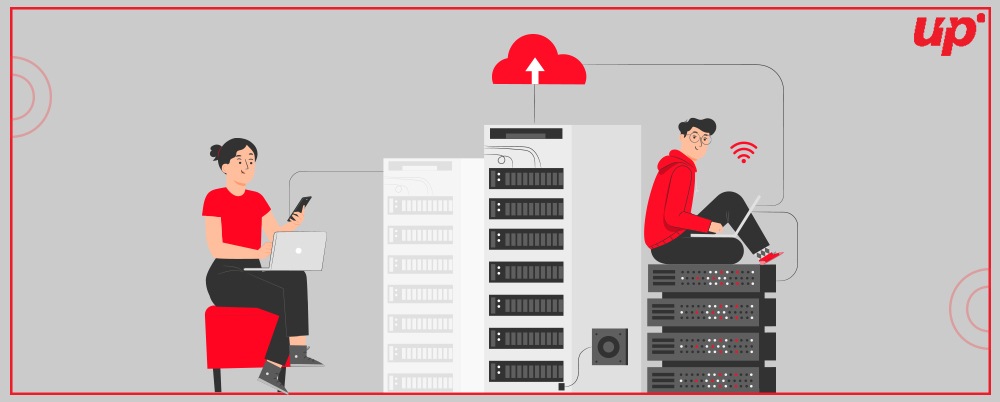The days have gone when the App Developers have to spend a lot of time thinking about the servers for purchasing, leasing, powering and installing in the data centre. The concept of serverless architecture let them free from that headache.
Serverless architecture is a method of developing and deploying applications and services without the need to manage infrastructure. Your application is still running on servers, but, it’ll be managed by a cloud computing platform. This is a cloud-based code execution model in which the cloud provider manages all backend resources.
The demand for Serverless architecture is increasing exponentially in Cloud based App Development. A survey has stated that more than 50% of companies will move to serverless architecture by 2025.
The Elements of a Serverless Architecture:

The serverless architecture is not entirely serverless because it includes some elements necessary for working with third-party servers. The following elements should be included in the framework of this cloud-based architecture for app development:
1. Token Security Service
Serverless users log into the system and use its services by using the API provided by third-party providers. Before users can use the API, the infrastructure should generate a security token.
2. The Web Server
The web server required to run client apps should be powerful enough to handle all of the static CSS, HTML, and JavaScript required.
3. Solution as a Service
A serverless infrastructure would not be complete without a FaaS (Function as a Service) solution. It enables developers to build, run, deploy, and maintain apps without the need for a server.
4. User Verification
Clients usually register for the service in a standard serverless environment. Serverless computing ensures that every end user can easily register and log into the application.
5. Client Software
Regardless of the state of your server infrastructure, the client interface should function on the client side. As a result, client applications can easily run on a web server.
6. Database
A solid database is now an essential component of this cloud-based infrastructure.
How does Serverless Architecture Work?
It defines a model in which a third party manages all servers and backend functions such as databases, security, and storage. The company does not need to handle the infrastructure. It allows them to concentrate on other core parts of development, like building business logic and writing the code and deploying the applications on a server hosted by a third party, who manages all logistics and backend support like hardware management, processes like multi-threading, allocation of virtual machines, etc. Management and maintenance are handled entirely by service providers such as AWS, Google, and IBM. Serverless architecture is also known as “function-as-a-service.” The following architecture shows how it works on Cloud based App Development.
The Market share of Cloud based App Development:

Cloud applications’ scalability and flexibility, as well as the customization offered by various cloud service providers, are assisting enterprises in adopting cloud applications. The way Serverless architecture app development is growing, it is expected that the market size will grow to USD 356 billion by 2025 from USD 171 billion in 2020, at a Compound Annual Growth Rate (CAGR) of 15.8% in this forecasting period.
Top Benefits of Cloud based App Development

There are many benefits to Serverless architecture app development. But, the top advantages of Serverless architecture in Cloud based App Development are as follows.
· Zero responsibility for server management
The servers that your application will use are managed by a third party, such as a cloud provider, according to the principles of serverless computing. This allows you to concentrate on other aspects, such as the front end and user experience.
· Scalable
Investing in architecture for your applications on your own carries significant risk because you never know what the outcome will be. Purchasing and maintaining servers can be expensive, and expanding becomes more difficult as you develop your application. If you use serverless architecture, you won’t have to worry about these issues, and scalability will be simplified.
· Cost-effective
One of the most important benefits of this type of Serverless architecture app development is it provides the same quality of service in different areas that saves a good amount of money. In traditional architecture, it is necessary to be cautious and purchase additional servers in the event of downtime or performance bottlenecks. Serverless architecture only charges you when it is used, i.e. when an event is triggered, so you only pay for the services you use.
· Low Operational Expenses
The cloud provider also handles maintenance, so businesses do not need to hire a separate team for this purpose. This also saves money on human resources.
· Quick update and deployment
As the development environment is more efficient and there is no pressure from the backend, the time it takes for the product to reach the market is significantly reduced. The features are also delivered more quickly to the user, who receives updates more frequently.
· Low Latency
The app’s response is an important factor that affects the efficiency of the Cloud based application. Latency is determined by physical location, and serverless apps can support global users by utilising global access points. As a result, serverless architecture improves app response time and ensures global coverage.
· Better Operation Management
Legacy systems have provided the architecture for companies to maximise their software. As these systems suppress innovation, relying on them can be detrimental to a business. Businesses should consider innovation when using serverless infrastructure in Cloud based App Development since the providers handle all architectural requirements.
-
Pivoting Enhancement
Serverless architecture makes easy execution and maintenance over traditional servers. Many businesses believe they have targeted the right audience or that their product is perfect.
Serverless architecture app development, on the other hand, enables businesses to innovate quickly and achieve rapid results. Startups can pivot into a business with greater freedom and benefit.
Top Challenges of Cloud based App Development:
Serverless Architecture for Cloud-based App Development is indeed very beneficial though the developers are facing a few challenges. The challenges of Serverless architecture app development are as follows.
· Lock-in of vendors
Outsourcing backend support to a third party necessitates complete faith in the vendor. You claim that your resources are limited and that you must rely on them for all services. If there is a problem, it cannot be solved on your terms and promptly. You must be patient while the service provider resolves the issue. Switching from one provider to another, for example, from AWS Lambda to Azure, is also difficult.
-
Testing and debugging
It is critical to understand how the backend works and where the error occurs when debugging and testing the application. This is difficult to see completely in Serverless architecture app development. Integration tests are also more difficult to perform because the environment is difficult to replicate.
-
Security threats
At the same time, many clients can connect to the server. There is a risk of a lack of data abstraction, and data can be compromised as a result of an infrastructure failure.
-
Steep Learning curve
Despite the abundance of resources available on the Internet, understanding and learning about FaaS (Function as a service) can be complicated. Furthermore, to implement the serverless architecture, the monolith structure must be broken down into microservices, which necessitates the expertise and assistance of professionals.
Genres of Serverless architecture:
Some popular genres of serverless computing that are used in Cloud based App Development and they are as follows.
· IoT backend:
The serverless infrastructure allows the developers to focus on making logics that kickstart database search for some devices, providing activation codes when devices ask for access, and device registration rule.
· Web Application Architecture
In terms of developing web application architecture, cloud providers enable you to create APIs and connect to cloud services. It’s as simple as logging into your account and entering the codes.
· Mobile Application Backend
In Cloud based App Development, this architecture provides the backend support to the native app. Netflix is one of the examples of Cloud based Application that is powered by AWS Lambda.
Final Thought:
Despite its many challenges, we can consider serverless architecture to be the future of modern app development. After all, it enables low-cost Cloud-based App Development, simple operation scalability, and shorter time to market.
Still, serverless architecture is in its infancy as it is only five years old. It is gaining popularity as a result of it has numerous advantages. However, it should be more transparent, secure, and robust for a wide range of applications. Organizations that provide serverless cloud services should develop additional operational tools and metrics and make them available to developers for easy debugging and maintenance.
If you have a plan for Cloud-based App Development using serverless architecture, you must have to contact a reputed Mobile App Development Company that can build your desired app with this technology.









